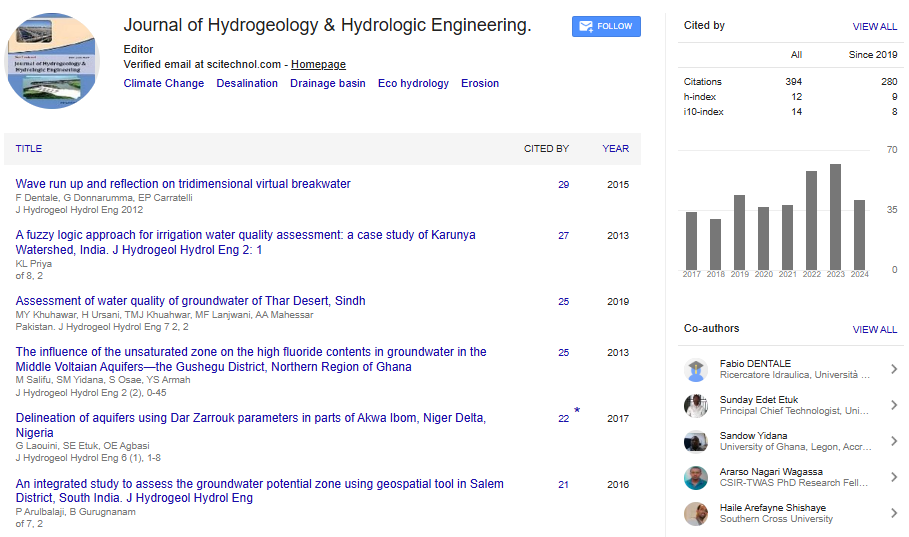Research Article, J Hydrogeol Hydrol Eng Vol: 8 Issue: 5
Experimental Analysis of Impact of Seepage Velocity on Mass Flux of Seawater in Coastal Aquifers
Oludotun Omoniyi Faluyi1*, Olufemi Sijuade Bamigboye2, Toba Emmanuel Bamidele2 and Taofeeq Ayinde Issa2
1Department of Physics and Materials Science, Kwara State University, Malete, Kwara State, Nigeria
2Department of Geology and Mineral Sciences, Kwara State University, Malete, Kwara State Nigeria
*Corresponding Author : Oludotun Omoniyi Faluyi
Department of Physics and Materials Science, Kwara State University, Malete, Kwara State, Nigeria
Tel: +234 8033772597
E-mail: oludotunfaluyi@gmail.com
Received: November 06, 2019 Accepted: November 21, 2019 Published: November 29, 2019
Citation: Faluyi OO, Bamigboye OS, Bamidele TE, Issa TA (2019) Experimental Analysis of Impact of Seepage Velocity on Mass Flux of Seawater in Coastal Aquifers. J Hydrogeol Hydrol Eng 8:3.
Abstract
Excessive abstraction of freshwater at coastal regions may reverse the direction of flow of mass flux of dissolved salts (J) leading to Saltwater Intrusion (SI) contaminating freshwater in coastal aquifers. This work investigated the impact of seepage velocities and hydraulic gradients of various porous media on mass flux of saltwater contaminant. Darcy’s and Fick’s laws were used to develop a model which gives J as a function of seepage velocity (V) and hydraulic gradient i. In validating the model, an experiment was designed to determine J in which river bed sand were washed, dried and sieved into five different grain sizes of samples using electric sieve with mesh ranged. The Ø of each sample was determined using volumetric technique. Two vertical arms of calibrated cylinder glass with diameter were joined with a similar glass cylinder in the horizontal position which housed the samples. Samples screened at both ends of length x were inserted into the glass with air completely eliminated using displacement method before commencement of flow experiment. The V and i were determined for five samples after which J was determined at interface and at other points. The values of seepage velocity V, mass flux J and hydraulic gradient I for various samples at time intervals of 60 seconds to 300 seconds were obtained from the experimental procedure. The plots of Seepage Velocity V against Mass flux showed increase in seepage velocity with mass flux but there is a limit point at which the seepage velocity decreases with increase in mass flux. The results confirmed that the hydraulic gradient required to drive the mass flux through the samples reduce with increase in porosity.
 Spanish
Spanish  Chinese
Chinese  Russian
Russian  German
German  French
French  Japanese
Japanese  Portuguese
Portuguese  Hindi
Hindi 
